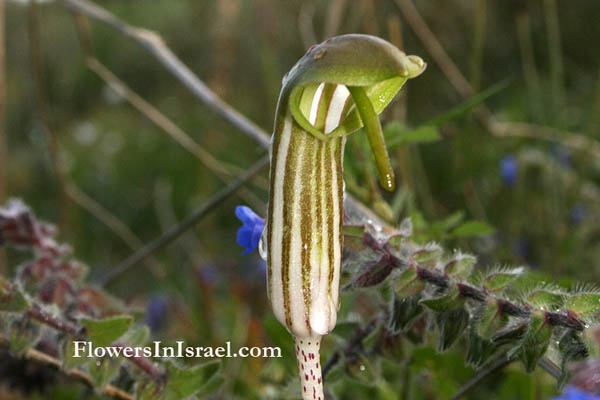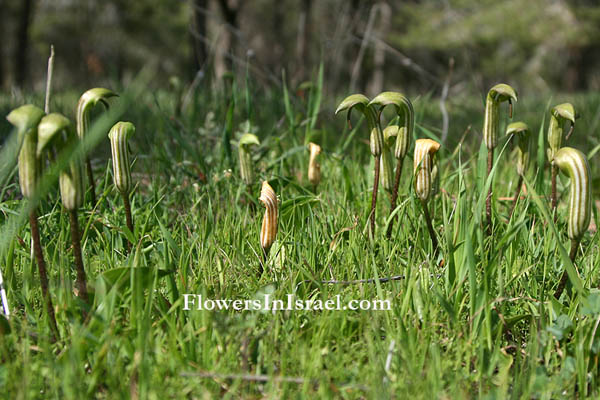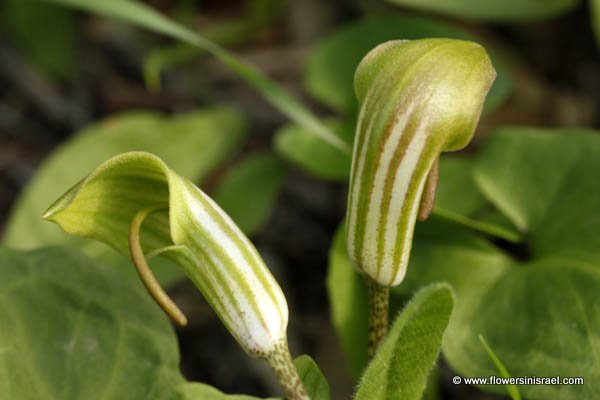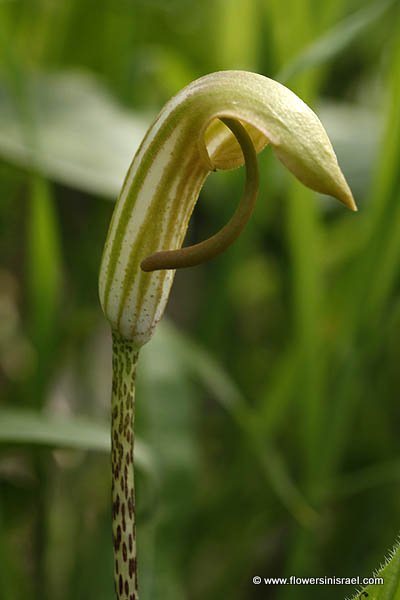Hebrew: לופית מצויה, Arabic: الصرين الشائع
| Scientific name: | Arisarum vulgare Targioni-Tozzetti | |
| Synonym name: | Arisarum vulgare L. | |
| Common name: | Aharon's Rod | |
| Hebrew name: | לופית מצויה | |
| Arabic name: | الصرين الشائع | |
| Family: | Araceae, Arum family, לופיים |

|
| Life form: | Geophyte | |
| Stems: | 10–30cm high; erect and unbranched, grow directly from underground rhizome; petioles and inflorescence stems have dark spots and flecks that resemble ants (Formicidae) in size and shape | |
| Leaves: | Rosette, entire | |
| Flowers: | No petals and tepals | |
| Fruits / pods: | Green berries of about 1cm long; 2-6 irregular pale brown seeds; each seed has numerous longitudinal ridges | |
| Flowering Period: | January, February, March, April, October, November, December | |
| Habitat: | Batha, Phrygana | |
| Distribution: | Mediterranean Woodlands and Shrublands, Montane vegetation of Mt. Hermon | |
| Chorotype: | Mediterranean | |
| Summer shedding: | Ephemeral |

Derivation of the botanical name: Arisarum, arisaron (as used by Dioscorides in reference to aris, aridos, the name of a small herb mentioned by Pliny, possibly Arisarum itself, and aron (Arum). vulgare, common. The Hebrew word: לופית, lufit, from לןף, luf with the small final addition (-it), to indicate the small size of the species compared to other plants of the Araceae, Arum family. From Aramaic: לופא, Lufa, Arabic: לופ, lup.
The plant grows from an underground tuberous rhizome hence a creeping underground which give rise to new stalked leaves and flowers each year. Since the underground stem lives all year round, the plant is described as perennial, but actually, during the hottest period of the year, there are no aerial leaves or flowers. Every leaf and flower are supported by a single, unbranched stalk that grows directly from the underground tuber. The petioles (leafstalks) bear a single fleshy leaf about 10 to 18cm long and 6-8cm wide and have dark spots and flecks that resemble ants (Formicidae) in size and shape on the petioles and inflorescence stems, a visual insect mimicry that serves as herbivore repellent cues and are part of the defence system of the plants. In North Africa, the roots are much used in seasons of shortage. The root, which is not as large as an ordinary walnut, contains an acid juice, which makes it quite uneatable in the natural state. This is, however, removed by repeated washings and the residue is innoxious and nutritive. Arisum vulgare contains crystals of calcium oxalate. These needle-like crystals produce pain and edema when they contact lips, tongue, oral mucosa, conjunctiva, or skin. 

|